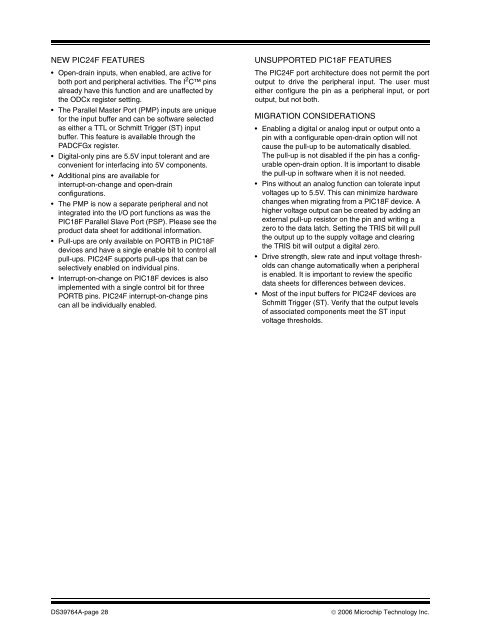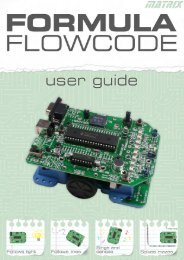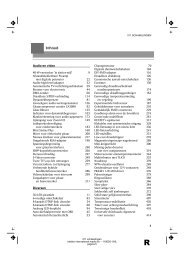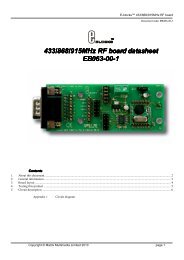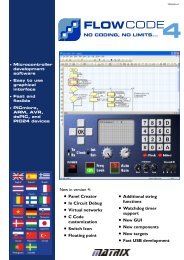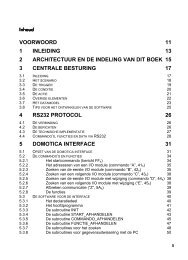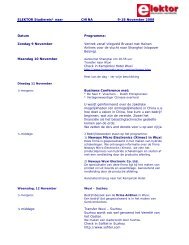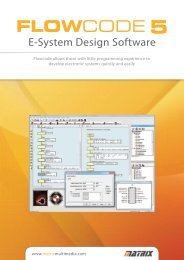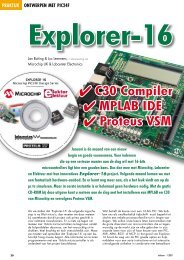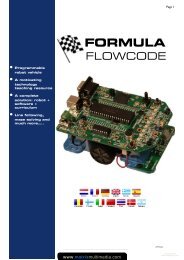NEW <strong>PIC24F</strong> FEATURES• Open-drain inputs, when enabled, are active forboth port and peripheral activities. The I 2 C pinsalready have this function and are unaffected bythe ODCx register setting.• The Parallel Master Port (PMP) inputs are uniquefor the input buffer and can be software selectedas either a TTL or Schmitt Trigger (ST) inputbuffer. This feature is available through thePADCFGx register.• Digital-only pins are 5.5V input <strong>to</strong>lerant and areconvenient for interfacing in<strong>to</strong> 5V components.• Additional pins are available forinterrupt-on-change and open-drainconfigurations.• The PMP is now a separate peripheral and notintegrated in<strong>to</strong> the I/O port functions as was the<strong>PIC18F</strong> Parallel Slave Port (PSP). Please see theproduct data sheet for additional information.• Pull-ups are only available on PORTB in <strong>PIC18F</strong>devices and have a single enable bit <strong>to</strong> control allpull-ups. <strong>PIC24F</strong> supports pull-ups that can beselectively enabled on individual pins.• Interrupt-on-change on <strong>PIC18F</strong> devices is alsoimplemented with a single control bit for threePORTB pins. <strong>PIC24F</strong> interrupt-on-change pinscan all be individually enabled.UNSUPPORTED <strong>PIC18F</strong> FEATURESThe <strong>PIC24F</strong> port architecture does not permit the por<strong>to</strong>utput <strong>to</strong> drive the peripheral input. The user musteither configure the pin as a peripheral input, or por<strong>to</strong>utput, but not both.MIGRATION CONSIDERATIONS• Enabling a digital or analog input or output on<strong>to</strong> apin with a configurable open-drain option will notcause the pull-up <strong>to</strong> be au<strong>to</strong>matically disabled.The pull-up is not disabled if the pin has a configurableopen-drain option. It is important <strong>to</strong> disablethe pull-up in software when it is not needed.• Pins without an analog function can <strong>to</strong>lerate inputvoltages up <strong>to</strong> 5.5V. This can minimize hardwarechanges when migrating from a <strong>PIC18F</strong> device. Ahigher voltage output can be created by adding anexternal pull-up resis<strong>to</strong>r on the pin and writing azero <strong>to</strong> the data latch. Setting the TRIS bit will pullthe output up <strong>to</strong> the supply voltage and clearingthe TRIS bit will output a digital zero.• Drive strength, slew rate and input voltage thresholdscan change au<strong>to</strong>matically when a peripheralis enabled. It is important <strong>to</strong> review the specificdata sheets for differences between devices.• Most of the input buffers for <strong>PIC24F</strong> devices areSchmitt Trigger (ST). Verify that the output levelsof associated components meet the ST inputvoltage thresholds.DS39764A-page 28© 2006 <strong>Microchip</strong> Technology Inc.
Timers (Timer1, Timer2/3 and Timer4/5)<strong>PIC24F</strong> timers support all of the <strong>PIC18F</strong> nanoWattfeatures, which include Asynchronous and SynchronousCounter modes, Timer modes and 32 kHz crystalsupport. <strong>PIC24F</strong> timers are designed <strong>to</strong> have moregeneric functions, whereas <strong>PIC18F</strong> timers are intendedfor dedicated purposes, such as PWM clock sources ora generic timer function. Each <strong>PIC24F</strong> 16-bit timer hasa dedicated period register, selectable prescaler andperiod match flag, and can operate in either Counter orTimer mode. <strong>PIC24F</strong> timers add new features, such asthe ability <strong>to</strong> combine two timers in<strong>to</strong> a single 32-bittimer and a timer gate option.TABLE 19: COMPARISON BETWEEN <strong>PIC18F</strong> AND <strong>PIC24F</strong> TIMER FEATURESFeature Description <strong>PIC18F</strong> <strong>PIC24F</strong>Timer Width 8/16-bit 16/32-bitGeneral Purpose Timer Mode All timers All timersAsynchronous Counter Mode Timer1 and 3 Timer1, 2 and 4Synchronous Counter Mode Timer0, 1 and 3 All timersPeriod Register Timer2 and 4 All timers32 kHz Crystal Support Timer1 Timer1Timer Gate Option No All timersPrescaler All timers All timersPostscaler Timer2 and Timer4 NoSpecial Event Trigger Yes YesSystem Clock Source Rate FOSC/4 FOSC/2Although all timer functionality of the <strong>PIC18F</strong> nanoWattdevices is available in the <strong>PIC24F</strong> family, different functionsmay reside in different timers. Like the <strong>PIC18F</strong>, all<strong>PIC24F</strong> timers can operate using the system clock asthe clock source. Where Asynchronous Counter modewas available in only Timer1 and 3 for <strong>PIC18F</strong>, thisfunction is available in Timer1, 2 and 4 for <strong>PIC24F</strong>.Synchronous Counter mode is provided in all <strong>PIC24F</strong>timers, as well as providing a dedicated period register.The period register resets the timer on a clock cyclematch and sets the interrupt flag in both architectures.However, when using the <strong>PIC24F</strong> period register,ensure the timer gate option is disabled.Prescalers are available in both architectures. <strong>PIC18F</strong>timers have different prescale ranges, but <strong>PIC24F</strong>timers use a standard range for all timers (1:1, 1:8, 1:64and 1:256).Both architectures support 32 kHz crystals throughTimer1, which can be optionally used as an accurate,low-power system clock source. Refer <strong>to</strong> the “Oscilla<strong>to</strong>r”and “Power-Saving Features” sections on pages 19and 23, respectively, for more information on usingTimer1 as a system clock.Other device similarities include:• Timers can operate if the device is in Sleep modewhen the timer is configured for AsynchronousCounter mode or Timer1 32 kHz Crystal mode.• All timer modes are available in Idle mode sincethe peripheral has a clock source.• Both Sleep and Idle mode can be exited on atimer interrupt event.• A Special Event Trigger is available <strong>to</strong> start anA/D conversion. Refer <strong>to</strong> the product data sheetfor which timer(s) is capable of generating aSpecial Event Trigger.TABLE 20: <strong>PIC18F</strong> AND <strong>PIC24F</strong> BIT EQUIVALENT TIMER FUNCTIONSFunctionality <strong>PIC18F</strong> <strong>PIC24F</strong>Timer Enable TMRxON TONDouble Read/Write Buffer Mode RD16 T32Timer1 System Clock Status T1RUN COSC2:COSC0 = 100(OSCCON)Timer Prescale Select TxCKPSx TCKPSxTimer1 Oscilla<strong>to</strong>r Enable T1OSCEN SOSCEN (OSCCON)Timer External Clock Synchronization TxSYNC TSYNCTimer Clock Source Select TMRxCS TCSTimer Postscale Select TxOUTPSx N/A© 2006 <strong>Microchip</strong> Technology Inc. DS39764A-page 29


